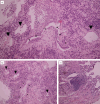Bronchiolar disorders in systemic autoimmune rheumatic diseases
- PMID: 40240060
- PMCID: PMC12000909
- DOI: 10.1183/16000617.0248-2024
Bronchiolar disorders in systemic autoimmune rheumatic diseases
Abstract
Pulmonary manifestations of systemic autoimmune rheumatic diseases (SARDs) may involve the large and small airways, lung parenchyma, pleura, respiratory muscles and thoracic cage. Bronchiolar disorders (BDs) or small airways disease (SAD) are common and may sometimes be the dominant presentation in patients with SARDs. We conducted a literature review using search terms "bronchiolitis," "small airway diseases" and the names of individual SARDs and collated relevant articles published between January 1977 and April 2024. A summary of the incidence/prevalence, clinical manifestations, pathogenetic mechanisms, pulmonary function testing, chest imaging, histopathology and treatment options for BDs associated with SARDs is provided in this review. BDs associated with Sjögren syndrome, rheumatoid arthritis, systemic sclerosis, systemic lupus erythematosus, idiopathic inflammatory myositis, mixed connective tissue disease and ankylosing spondylitis are specifically highlighted.
Copyright ©The authors 2025.
Conflict of interest statement
Conflict of interest: All authors have nothing to disclose.
Figures




Similar articles
-
Prevalence of systemic autoimmune rheumatic diseases and clinical significance of ANA profile: data from a tertiary hospital in Shanghai, China.APMIS. 2016 Sep;124(9):805-11. doi: 10.1111/apm.12564. Epub 2016 Jun 22. APMIS. 2016. PMID: 27328803
-
2023 American College of Rheumatology (ACR)/American College of Chest Physicians (CHEST) Guideline for the Screening and Monitoring of Interstitial Lung Disease in People with Systemic Autoimmune Rheumatic Diseases.Arthritis Rheumatol. 2024 Aug;76(8):1201-1213. doi: 10.1002/art.42860. Epub 2024 Jul 8. Arthritis Rheumatol. 2024. PMID: 38973714
-
Clinical aspects of autoimmune rheumatic diseases.Lancet. 2013 Aug 31;382(9894):797-808. doi: 10.1016/S0140-6736(13)61499-3. Lancet. 2013. PMID: 23993190 Review.
-
Cancer Risk in Patients With Inflammatory Systemic Autoimmune Rheumatic Diseases: A Nationwide Population-Based Dynamic Cohort Study in Taiwan.Medicine (Baltimore). 2016 May;95(18):e3540. doi: 10.1097/MD.0000000000003540. Medicine (Baltimore). 2016. PMID: 27149461 Free PMC article.
-
Thoracic Involvement in Systemic Autoimmune Rheumatic Diseases: Pathogenesis and Management.Clin Rev Allergy Immunol. 2022 Dec;63(3):472-489. doi: 10.1007/s12016-022-08926-0. Epub 2022 Mar 18. Clin Rev Allergy Immunol. 2022. PMID: 35303257 Free PMC article. Review.
References
Publication types
MeSH terms
LinkOut - more resources
Full Text Sources
Medical
Research Materials
Miscellaneous
